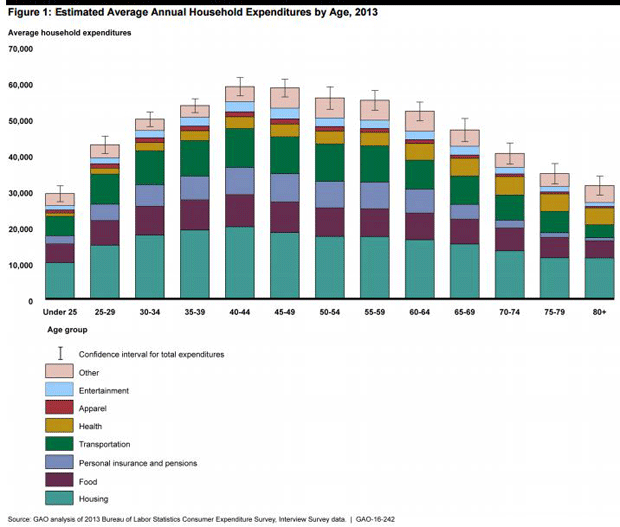How much retirement income do you really need?
The common wisdom about how much income Americans need in retirement may not be so wise, according to the U.S. Government Accountability Office.
The GAO, which reviewed 59 studies and reports on retirement income and interviewed retirement services firms and financial planners as part of the study, found that recommended target income replacement rates typically ranged from 70 to 85 percent of your pay just before retirement.
But those figures are only general targets -- they don't take into account your individual circumstances and goals, which can greatly affect how much income a given retiree needs.
Why calculate income replacement rates?
Many policymakers, employers and their advisors are concerned about the adequacy of existing retirement systems, such as Social Security and employer-sponsored retirement plans. As a result, they look for measures that help them with this assessment across broad populations.
Ideally it would be best to determine if workers will have enough retirement income to support their living expenses, but estimating living expenses can be difficult for targeted populations. It's easier to use retirement income as a proxy for living expenses.
Technically, a retirement income replacement rate is the ratio of two numbers: the total amount of income in retirement from all sources (Social Security, pensions, draw from savings and retirement work) divided by the income earned during your career phase. The 70 to 85 percent replacement targets are intended to give workers the same standard of living in retirement compared to their years just before retirement.
This is usually interpreted as having the same amount of disposable income in retirement, meaning you don't need to replace 100 percent of your income just before retirement because when you're retired, you'll pay lower income taxes, you won't pay Social Security taxes (currently 7.65 percent of taxable pay), and you no longer need to save for retirement.
One important and reasonable use of income replacement rates is to help younger, mid-career workers assess if their savings rates put them on track for a financially secure retirement.
Challenges with figuring out income replacement
Simply put, it's not easy to calculate income replacement rates as a planning tool. Here's why:
- What pre-retirement income should you use? Some retirement income models assume you earn a smooth progression of increasing income until the year before you retire, then you retire completely with no income from working. That doesn't describe many people nowadays. Many people work part time in their later years, or their income tapers off during their last years of work, and many women have career interruptions due to child-raising responsibilities. Pegging a target retirement income to the amount you earned in your last year of employment may not be appropriate for many people.
- Your living needs can decrease substantially in retirement compared to your working years. The GAO report shows that, on average, peak spending years are ages 45-49, and average spending drops significantly for older groups. For example, in 2013, average household expenditures for people age in that age range were $58,500. But that average dropped 20 percent for young retirees (age 65-69), 41 percent for mid-retirees (75-79), and 46 percent for older retirees (80+).
- Housing is most people's largest living expense, and you can significantly reduce your housing expenses by paying off your mortgage or by downsizing. For example, in 2013 47 percent of Americans age 65-69 owned a home without a mortgage, a number that increased to 70 percent for Americans age 80 and over.
- Health care expenses typically increase significantly for retirees compared to younger workers, a factor should be taken into account when determining retirement income needs.
Other factors that influence the amount of retirement income needed relative to your income during your peak earning years include:
- Marital status and the number of children you have
- Desired spending on entertainment and travel
- Views on consumption - essentials vs. "nice to have"
- Health status
- Level of debt while working vs. in retirement
- Level of work-related expenses such as the cost of commuting
As you can imagine, these factors can vary tremendously for different households, and your spending needs can evolve as you age.
Do planners use replacement rates?
Tellingly, only six of the 14 retirement service providers and financial planners interviewed by GAO use replacement rates for their clients; of these, four used customized rates that reflect the circumstances of their clients. The remaining eight service providers questioned the usefulness of replacement rates for their clients, instead preferring to consider people's actual spending needs and unique circumstances.
(As a side note, I'm an actuary in my early 60s who has studied retirement for more than 40 years and written five books on retirement planning. I've never calculated my own personal replacement rate. I have estimated my basic and essential spending needs, which are much different from earlier years when my kids were living with me. I make sure that my estimated income meets my current spending needs, not some artificial target from my past.)
The bottom line is that income replacement rates are a useful assessment tool for policymakers and analysts, and they might be the best you can do when estimating how much to save when you're in your 30s, 40s, and 50s. But when you get closer to retirement, income replacement rates aren't effective planning tools. You'll want to refine your calculations by taking into consideration your unique goals and circumstances.

